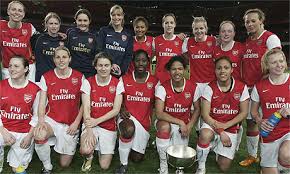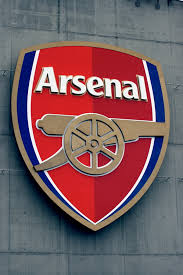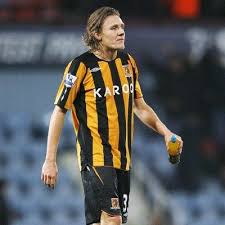 |  |  |  |  |
English Premier League
England
The Barclays English Premier League (EPL), considered as the best in the world.
Arsenal vs Hull City
Official name Arsenal FC
City London
Founded 1886
Club colors Red wine / White / Red wine
vs.
0 - 0
Hull City
Official name Hull City AFC
City Hull
Founded 1904
Club colors Black-Orange / Black / Black
Match scheduled:
Date: 19-12-2009
Time:17:30 until 19:30
Week 18 / Round 18 :: Barclays Premier League 2009/2010 :: SHTV/Guangdong JIP after the Club World Cup!
Arsenal were founded as Dial Square in 1886 by workers at the Royal Arsenal in Woolwich, and were renamed Royal Arsenal shortly afterwards.[3] They renamed themselves again to Woolwich Arsenal after turning professional in 1891.[4] The club joined the Football League in 1893, starting out in the Second Division, and won promotion to the First Division in 1904. The club's relative geographic isolation resulted in lower attendances than those of other clubs, which led to the club becoming mired in financial problems and effectively bankrupt by 1910, when they were taken over by Henry Norris.[5] Norris sought to move the club elsewhere, and in 1913, soon after relegation back to the Second Division, Arsenal moved to the new Arsenal Stadium in Highbury, North London; they dropped "Woolwich" from their name the following year.[6] Arsenal only finished in fifth place in 1919, but nevertheless were elected to rejoin the First Division at the expense of local rivals Tottenham Hotspur, by reportedly dubious means.[7]

In 1925, Arsenal appointed Herbert Chapman as manager. Chapman had already won the league twice with Huddersfield Town in 1923–24 and 1924–25, and he brought Arsenal their first period of major success. His revolutionary tactics and training, along with the signings of star players such as Alex James and Cliff Bastin, laid the foundations of the club's domination of English football in the 1930s.[8] Under his guidance Arsenal won their first major trophies – an FA Cup in 1930 and two League Championships, in 1930–31 and 1932–33. In addition, Chapman was behind the 1932 renaming of the local London Underground station from "Gillespie Road" to "Arsenal", making it the only Tube station to be named specifically after a football club.[9]
Chapman died suddenly of pneumonia in early 1934, leaving Joe Shaw and George Allison to carry on his successful work. Under their guidance, Arsenal won three more titles (1933–34, 1934–35 and 1937–38) and an FA Cup (1936). As key players retired, by the decade's end, Arsenal had started to fade, and then the intervention of the Second World War meant competitive professional football in England was suspended.[10][11][12]
After the war, under Allison's successor Tom Whittaker, Arsenal enjoyed a second period of success, winning the league in 1947–48 and 1952–53, and the FA Cup in 1950. After that though, their fortunes waned; unable to attract players of the same calibre as they had in the 1930s, the club spent most of the 1950s and 1960s in trophyless mediocrity. Even former England captain Billy Wright could not bring the club any success as manager, in a stint between 1962 and 1966.[12][13][14]
Arsenal began winning silverware again with the surprise appointment of club physiotherapist Bertie Mee as manager in 1966. After losing two League Cup finals, they won the Inter-Cities Fairs Cup, their first European trophy, in 1969–70. This was followed by an even greater triumph: their first League and FA Cup double in 1970–71.[15] This marked a premature high point of the decade; the Double-winning side was soon broken up and the following decade was characterised by a series of near misses. Arsenal finished as First Division runners-up in 1972–73, lost three FA Cup finals (1972, 1978 and 1980) and lost the 1980 Cup Winners' Cup final on penalties. The club's only success during this time was an FA Cup win in 1979, with a last-minute 3–2 victory over Manchester United that is widely regarded as a classic.[12][16]
The return of former player George Graham as manager in 1986 brought a third period of glory. Arsenal won the League Cup in 1986–87, Graham's first season in charge. This was followed by a League title win in 1988–89, won with a last-minute goal in the final game of the season against fellow title challengers Liverpool. Graham's Arsenal won another title in 1990–91, losing only one match, won the FA Cup and League Cup double in 1992–93 and a second European trophy, the Cup Winners' Cup, in 1993–94.[12][17] Graham's reputation was tarnished when it was revealed that he had taken kickbacks from agent Rune Hauge for signing certain players,[18] and he was dismissed in 1995. His replacement, Bruce Rioch, lasted for only one season, leaving the club after a dispute with the board of directors.[19]
The club's success in the late 1990s and 2000s owed a great deal to the appointment of Arsène Wenger as manager in 1996. Wenger brought new tactics, a new training regime and several foreign players who complemented the existing English talent. Arsenal won a second League and Cup double in 1997–98 and a third in 2001–02. In addition, the club reached the final of the 1999–2000 UEFA Cup (losing on penalties to Galatasaray), were victorious in the 2003 and 2005 FA Cups, and won the Premier League in 2003–04 without losing a single match, an achievement which earned the side the nickname "The Invincibles";[20] in all, the club went 49 league matches unbeaten, a national record.[21]
Arsenal finished in either first or second place in the league in eight of Wenger's first eleven seasons at the club, though on no occasion were they able to retain the title.[12] As of 2009, they were one of only four teams, the others being Manchester United, Blackburn Rovers and Chelsea, to have won the Premier League since its formation in 1992.[22] Arsenal had never progressed beyond the Champions League quarter-finals until 2005–06; in that season they became the first club from London in the competition's fifty-year history to reach the final, in which they were beaten 2–1 by Barcelona.[23] In July 2006, they moved into the Emirates Stadium, after 93 years at Highbury.[24]
Royal Arsenal's first crest, unveiled in 1888, featured three cannons viewed from above, pointing northwards, similar to the coat of arms of the Metropolitan Borough of Woolwich. These can sometimes be mistaken for chimneys, but the presence of a carved lion's head and a cascabel on each are clear indicators that they are cannons.[25] This was dropped after the move to Highbury in 1913, only to be reinstated in 1922, when the club adopted their first single-cannon crest, featuring an eastward-pointing cannon, with the club's nickname, The Gunners, inscribed alongside it; this crest only lasted until 1925, when the cannon was reversed to point westward and its barrel slimmed down.[25] In 1949, the club unveiled a modernised crest featuring the same style of cannon, the club's name set in blackletter above the cannon, the coat of arms of the Metropolitan Borough of Islington and a scroll inscribed with the club's newly adopted Latin motto, Victoria Concordia Crescit (meaning "victory comes from harmony"), coined by Harry Homer, the club's programme editor.[25] For the first time, the crest was rendered in colour, which varied slightly over the crest's lifespan, finally becoming red, gold and green.
Because of the numerous revisions of the crest, Arsenal were unable to copyright it. Although the club had managed to register the crest as a trademark, and had fought (and eventually won) a long legal battle with a local street trader who sold "unofficial" Arsenal merchandise,[26] Arsenal eventually sought a more comprehensive legal protection. Therefore, in 2002 they introduced a new crest featuring more modern curved lines and a simplified style, which was copyrightable.[27] The cannon once again faces east and the club's name is written in a sans-serif typeface above the cannon. Green was replaced by dark blue. The new crest received a critical response from some supporters; the Arsenal Independent Supporters' Association claimed that the club had ignored much of Arsenal's history and tradition with such a radical modern design, and that fans had not been properly consulted on the issue.[28]
For the majority of their time in south-east London, Arsenal played at the Manor Ground in Plumstead, a three-year period at the nearby Invicta Ground between 1890 and 1893 excepted. The Manor Ground was initially just a field, until the club installed stands and terracing in time for their first Football League match in September 1893. They played their home games there for the next twenty years (with two exceptions in 1894–95), until the move to north London in 1913.[35][36]
Arsenal Stadium, widely referred to as Highbury, was Arsenal's home from September 1913 until May 2006. The original stadium was designed by the renowned football architect Archibald Leitch, and had a design common to many football grounds in the UK at the time, with a single covered stand and three open-air banks of terracing.[37] In the 1930s, the entire stadium was given a massive overhaul, with new Art Deco West and East stands constructed, opening in 1932 and 1936 respectively;[37] in addition, the North Bank terrace had a roof added, which was later bombed during the Second World War and not restored until 1954.[37]
At its peak, Highbury could hold over 60,000 spectators, and had a capacity of 57,000 until the early 1990s. The Taylor Report and Premier League regulations forced Arsenal to convert Highbury to an all-seater stadium in time for the 1993–94 season, reducing the capacity to 38,419 seated spectators.[38] This capacity had to be reduced further during Champions League matches to accommodate additional advertising hoardings, so much so that for two seasons (1998–99 and 1999–2000) Arsenal played Champions League home matches at Wembley, which could house more than 70,000 spectators.[39]
Expansion of Highbury was restricted because the East Stand had been designated as a Grade II listed building and the other three stands were close to residential properties.[37] These limitations prevented the club from maximising matchday revenue during the 1990s and early 2000s, putting them in danger of being left behind in the football boom of that time.[40] After considering various options, in 2000 Arsenal proposed building a new 60,355-capacity stadium at Ashburton Grove, since renamed the Emirates Stadium, about 500 metres south-west of Highbury.[41] The project was initially delayed by red tape and rising costs,[42] and construction was completed in July 2006, in time for the start of the 2006–07 season.[43] The stadium was named after its sponsors, the airline company Emirates, with whom the club signed the largest sponsorship deal in English football history, worth approximately £100 million;[44] some fans referred to the ground as Ashburton Grove, or the Grove, as they did not agree with corporate sponsorship of stadium names.[45] The stadium will be officially known as Emirates Stadium until at least 2012, and the airline will be the club's shirt sponsor until the end of the 2013–14 season.[44]
Between 1904 and 1905, Hull City played their home games at The Boulevard.[48] This ground was used by Hull on a contract which allowed them to use it when not used for Rugby League, at a cost of £100 per annum.[49] Hull built their own ground, Anlaby Road, which was opened in 1906.[50] With the threat of the rerouting of the railway line through the Anlaby Road ground, the club was convinced it needed to secure its future by owning its own ground.[8] They negotiated the deal for land between Boothferry Road and North Road in 1929, which was financed by a £3,000 loan from the FA.[51] Due to the club's financial difficulties, no work took place for three years, and development then stopped until 1939. In that year a proposal to build a new multi-purpose sports stadium on the site temporarily halted the club's plans to relocate, but when this plan failed the club resolved to continue with the stalled development of the site, in anticipation of moving to the new stadium in 1940. The outbreak of war, however, meant that the redevelopment again came to a halt, as the site was taken over by the Home Guard.[8]
During the Second World War, Anlaby Road was damaged by enemy bombing, the repair cost of which was in the region of £1,000. The Cricket Club served notice to quit at the same time, and so in 1943 the tenancy was officially ended.[50] Hull were forced to return to the Boulevard Ground from 1944 until 1945 because of the poor condition of the planned stadium at Boothferry Road.[49] The new stadium was finally opened under the revised name of Boothferry Park on 31 August 1946.[8]
Hull City, along with one of the city's rugby league sides, Hull F.C., moved into the newly-built KC Stadium in 2002.[8] The KC Stadium was named "Best Ground" at the 2006 Football League Awards.[52]
 |  |  |












